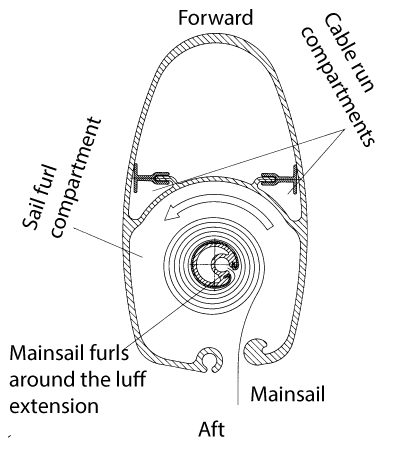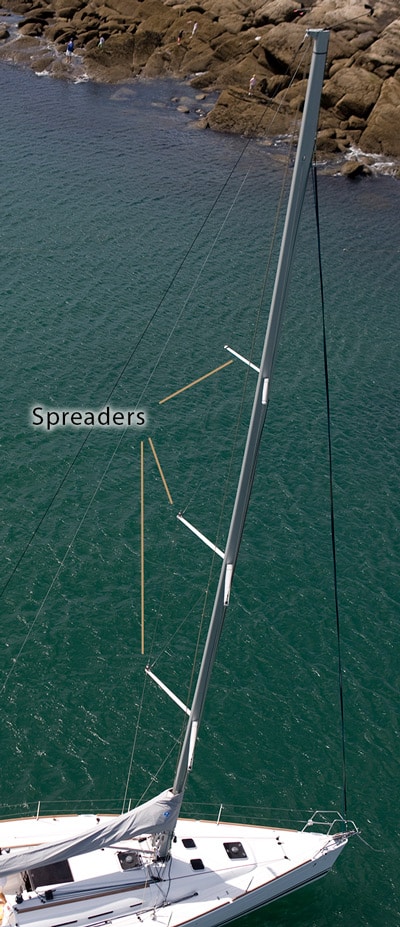
This article is an excerpt from NauticEd’s online Skipper Large Keelboats Course, a comprehensive online sailing course for beginner to intermediate sailors to learn how to sail large sailboats 26 ft (8m) and above. The Skipper Large Keelboats course is part of the Skipper Course Bundle of online courses, also teaching you how to master maneuvering under power and docking!
You can learn to sail and improve your sailing with NauticEd, the international leader in sailing education.
Standing Rigging
To keep the mast from toppling over, an array of rods, cables, ropes (lines), and wires are attached at various spots on the mast and run down to the bow, stern, and sides of the vessel. Professional riggers using highly specialized tools and standards are required to adjust all rigging properly. The process is called tuning the rig.
Cables, wires, or rods running from various points on the mast to the vessel’s deck are stays. Stays are identified as forestay, backstay, port, and starboard sidestays depending upon where they are attached to the deck. Sidestays are also known as shrouds. Stays ensure that the mast remains upright as well as assist in the transfer of energy from the mast’s sail to the vessel’s hull. Vessels currently produced by some manufacturers have eliminated the backstay by shifting the connection to the deck of the side stays to a more aft position. This rigging design is called the B&R rig. Some argue that the B&R rig reduces performance and prefers to stick with a backstay. The advantage of the B&R rig is that without a backstay in the way, an arch over the top of the cockpit can be used to house the traveler for the main sheet. This is typically done on cruising boats. Sailboat racers frown at this design.
Whatever your preference, the standing rigging is all the stuff that provides support to the sails but does not move.
Click on the circles in the image below.
Standing Rigging
The Mast
The mast is simply a strong spar, or “stick,” that reaches upward into the air to hold the sails. The mast is attached to the vessel, sometimes through the top deck and down to the keel, though sometimes it sits on the top deck and is supported by compression posts underneath.
When the mast goes directly to the keel the sailboat is said to be “keel-stepped,” but if it attaches to the deck it is called “deck-stepped.” Most vessels in the 30 to 50-foot (10 to 16 m) range are deck-stepped.
This deck-stepped arrangement allows for a variety of sail designs and opportunities for diversified salon designs.
Masts are often aluminum extrusions or made of carbon and/or fiberglass composite materials. Their shapes are sometimes complex because they house electric wires going to the top of the mast. In some cases, there is a vertical rod in which the sail furls around inside a cavity in the mast. This is called a roller furling mast.

Roller Furler Mast Extrusion
The Spreaders
Spreaders are rigid structures attached perpendicularly to the mast. The act to strengthen the mast in conjunction with the side stay wires (shrouds). You will note that on some vessels spreaders are swept back, while on others they are not. There may be several sets of spreaders on larger vessels.
As stronger and lighter materials are being created, masts and their spreaders are modified to better support sails and provide for different rigging configurations.

Spreaders
You can learn more in the Skipper Course....
Knowledge and theory for longer distances and overnight sailing in diverse conditions. The Skipper Course is a comprehensive online sailing course for beginner to intermediate sailors wanting to learn how to sail larger sailboats 26ft to 56ft. Or upgrade to the Skipper Course Bundle of online courses to also master maneuvering under power and docking!
